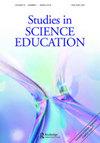手绘作为促进大学生理解人类生物学的工具:对文献的批判性回顾和未来展望
IF 9.9
2区 教育学
Q1 EDUCATION & EDUCATIONAL RESEARCH
引用次数: 2
摘要
科学和绘画已经结合了数百年,这种协同作用在研究绘画对发展和评估理解的作用方面仍然普遍存在。然而,尽管在小学和中学阶段进行了研究,但关于绘画是否有助于大学阶段的学习,特别是在人类生物学方面,研究有限。这个主题特别重要,因为它可以成为一些多学科课程的核心主题,而这些课程在入学时不需要科学背景。本文回顾的文献强调,绘画任务深受学生欢迎,他们认为这些任务有助于他们的理解。还有一些证据表明,它可能会改善学习。然而,由于比较组的一些限制,这一点不能可靠地得出结论,包括没有这样的组,使用回顾性队列作为对照,并且不控制组之间的指导。此外,报告中的一些测试改进实际上非常小。在这方面需要做更多的工作,因为存在误解可能会传递给学生以及在使用这种教学活动的学生之间的风险。本文章由计算机程序翻译,如有差异,请以英文原文为准。
Hand drawing as a tool to facilitate understanding in undergraduate human biology: a critical review of the literature and future perspectives
ABSTRACT Science and drawing have been paired for hundreds of years, and this synergy is still prevalent in research investigating the role of drawing for developing and assessing understanding. However, despite research at the primary and secondary levels of education, there is limited research on whether drawing facilitates learning at the undergraduate level, particularly in human biology. This subject is specifically important to focus on as it can be a core subject on some multidisciplinary programmes that do not require a science background at entry. The literature reviewed in this paper highlights that drawing tasks are well received by students and that they perceive the tasks to be helpful for their understanding. There is also some evidence that it might improve learning. However, this cannot be concluded with confidence due to some limitations with respect to comparison groups, including such a group being absent, using retrospective cohorts as a control, and not controlling for instruction between groups. Furthermore, some of the reported improvements in tests are practically very small. More work is warranted in this area as there is a risk that misconceptions can be passed on to students and between students using this type of teaching activity.
求助全文
通过发布文献求助,成功后即可免费获取论文全文。
去求助
来源期刊

Studies in Science Education
EDUCATION, SCIENTIFIC DISCIPLINES-
CiteScore
15.30
自引率
2.00%
发文量
7
审稿时长
>12 weeks
期刊介绍:
The central aim of Studies in Science Education is to publish review articles of the highest quality which provide analytical syntheses of research into key topics and issues in science education. In addressing this aim, the Editor and Editorial Advisory Board, are guided by a commitment to:
maintaining and developing the highest standards of scholarship associated with the journal;
publishing articles from as wide a range of authors as possible, in relation both to professional background and country of origin;
publishing articles which serve both to consolidate and reflect upon existing fields of study and to promote new areas for research activity.
Studies in Science Education will be of interest to all those involved in science education including: science education researchers, doctoral and masters students; science teachers at elementary, high school and university levels; science education policy makers; science education curriculum developers and text book writers.
Articles featured in Studies in Science Education have been made available either following invitation from the Editor or through potential contributors offering pieces. Given the substantial nature of the review articles, the Editor is willing to give informal feedback on the suitability of proposals though all contributions, whether invited or not, are subject to full peer review. A limited number of books of special interest and concern to those involved in science education are normally reviewed in each volume.
 求助内容:
求助内容: 应助结果提醒方式:
应助结果提醒方式:


